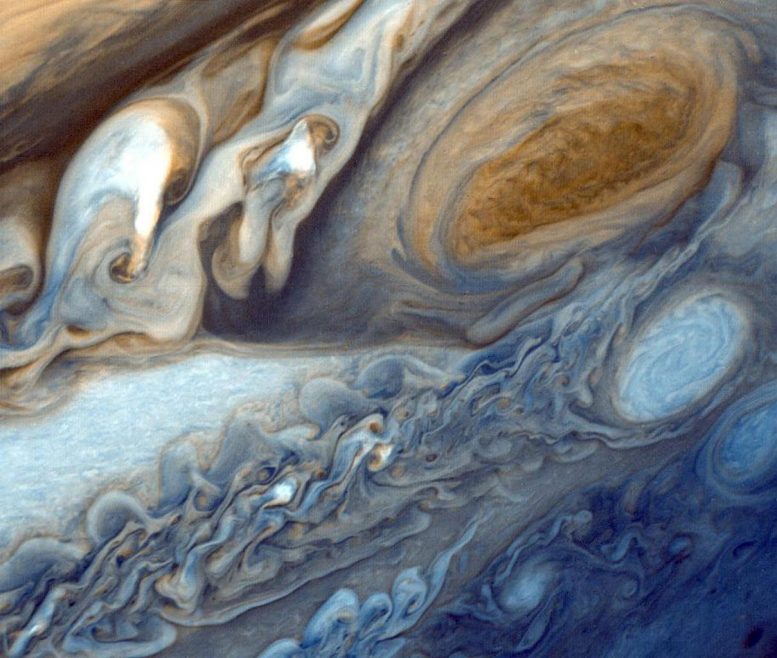
Jupiter’s Great Red Spot has been swirling wildly over Jupiter’s skies for the past 150 years—maybe even much longer than that.
NASA scientists continue to study Jupiter and its Great Red Spot, hoping to solve the mystery of its swirl of reddish hues.
The largest and most powerful hurricanes ever recorded on Earth spanned over 1,000 miles (1,600 kilometers) across with winds gusting up to around 200 mph (320 kph). That’s wide enough to stretch across nearly all U.S. states east of Texas. But even that kind of storm is dwarfed by the Great Red Spot, a gigantic storm in Jupiter. There, gigantic means twice as wide as Earth.
With tumultuous winds peaking at about 400 mph (640 kph), the Great Red Spot has been swirling wildly over Jupiter’s skies for the past 150 years—maybe even much longer than that. While people saw a big spot in Jupiter as early as they started stargazing through telescopes in the 1600s, it is still unclear whether they were looking at a different storm. Today, scientists know the Great Red Spot is there and it’s been there for a while, but they still struggle to learn what causes its swirl of reddish hues.
Understanding the Great Red Spot is not easy, and it’s mostly Jupiter’s fault. A planet a thousand times as big as Earth, Jupiter consists mostly of gas. A liquid ocean of hydrogen surrounds its core, and the atmosphere consists mostly of hydrogen and helium. That translates into no solid ground like we have on Earth to weaken storms. Also, Jupiter’s clouds obstruct clear observations of its lower atmosphere. While some studies of Jupiter have investigated areas in its lower atmosphere, orbiting probes and telescopes studying the Great Red Spot can only see clouds scattered high in the atmosphere.
Amy Simon, an expert in planetary atmospheres at NASA’s Goddard Space Flight Center in Greenbelt, Maryland, said learning more about Jupiter and its Great Red Spot could help scientists understand Earth’s weather system better. Jupiter’s weather functions under the same physics as Earth, she said, just millions of miles farther from the sun. Simon also said Jupiter studies could improve our understandings of worlds beyond our solar system. “If you just look at reflected light from an extrasolar planet, you’re not going to be able to tell what it’s made of,” Simon said. “Looking at as many possible different cases in our own solar system could enable us to then apply that knowledge to extrasolar planets.”
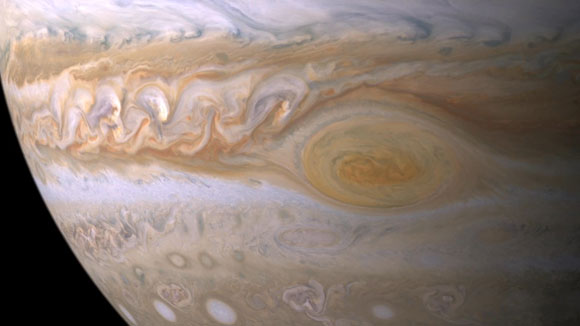
Trapped between two jet streams, the Great Red Spot is an anticyclone swirling around a center of high atmospheric pressure that makes it rotate in the opposite sense of hurricanes on Earth. Credit: NASA/JPL/Space Science Institute
Studies predict Jupiter’s upper atmosphere has clouds consisting of ammonia, ammonium hydrosulfide, and water. Still, scientists don’t know exactly how or even whether these chemicals react to give colors like those in the Great Red Spot. Plus, these compounds make up only a small part of the atmosphere. “We’re talking about something that only makes up a really tiny portion of the atmosphere,” Simon said. “That’s what makes it so hard to figure out exactly what makes the colors that we see.”
Like Simon, other scientists at Goddard work to shed light on the Great Red Spot’s mystery. Goddard scientists Mark Loeffler and Reggie Hudson have been performing laboratory studies to investigate whether cosmic rays, one type of radiation that strikes Jupiter’s clouds, can chemically alter ammonium hydrosulfide to produce new compounds that could explain the spot’s color.
Ammonium hydrosulfide is unstable under Earth’s atmospheric conditions, so Loeffler makes his own batch by heating hydrogen sulfide and ammonia together. He then blasts them with charged particles, similar to the cosmic rays impacting Jupiter’s clouds. “Our first step is to try to identify what forms when ammonium hydrosulfide is irradiated,” Loeffler said. “We have recently finished identifying these new products, and now we are trying to correlate what we have learned with the colors in Jupiter. ”
Other experts agree with the leading theory that deep under Jupiter’s clouds, a colorless ammonium hydrosulfide layer could be reacting with cosmic rays or UV radiation from the sun. But Simon said many chemicals turn red under different situations. “That’s the problem,” she said. “Is it turning the right color red?” Under the right conditions, ammonium hydrosulfide might be.
With the Great Red Spot and other reddish parts of Jupiter, coloring may result from multiple factors, as opposed to just ammonium hydrosulfide. “Ideally, what you’d want is a mixture with the right components of everything that you see in Jupiter’s atmosphere at the right temperature, and then irradiate it at the right levels,” Simon said. Ultimately, Simon and Loeffler said solving the Great Red Spot’s mystery will take more experiments combining chemicals under the right temperatures, light exposures and radiation doses. “What we are trying to do is design lab experiments more realistic to Jupiter’s atmosphere,” Simon said.
Reference: “Giant-planet chemistry: Ammonium hydrosulfide (NH4SH), its IR spectra and thermal and radiolytic stabilities” by Mark J. Loeffler, Reggie L. Hudson, Nancy J. Chanover and Amy A. Simon, 2 July 2015, Icarus.
DOI: 10.1016/j.icarus.2015.06.015
Funded by NASA’s Planetary Atmospheres and Outer Planets programs, Loeffler, Simon and Hudson’s research is published in the journal Icarus. New Mexico State University astronomer Nancy Chanover also takes part in their studies.




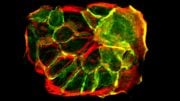

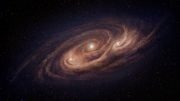
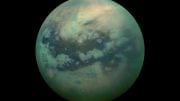

Alright! Jupiter’s Great Red spot is known as a tremendous cyclone going for 600 years probably. The upper atmosphere air it circulates should contain many gas molecules like sulphur di oxide , ammonia and hydrocarbons. It is in a lab condition where these gas molecules can undergo various other compounds emitting red colour to the cyclonic clouds that are present permanently for hundreds of years aided by the cosmic rays of high power gamma rays, ultra-violet and X-rays which is responsible for the reaction as catalyst. I don’t think that any ground phenomena had contributed for this change, in the giant gas planet. Thank YOu.
I believe that Jupiter, like all the other planets in the Solar System, is a captured “free planet”; and that prior to capture by the Sun, it was well on its way to becoming a star, having accumulated a thick gas coat and evidently having a large amount of internal heat which is keeping the violent circulation of that coat going. Unfortunately(?) it got stuck at that stage.
Why the spot is red doesn’t interest me. I am, however, most interested in three facts: (1) the spot has been fixed in position for at least
the hundreds of years during which it has been noted by astronomers, which just doesn’t happen with weather patterns; (2) it is clearly elliptical in shape, and that shape also has not changed over the same period – again, that just doesn’t happen with weather patterns; and (3) The spot is gradually getting smaller.
My explanation for all this is that the Red Spot is the visible evidence in Jupiter’s weather of a vortex which is fixed in position over a huge crater in the surface of Jupiter’s solid core. It’s elliptical because the crater – like the Tibetan Plateau on Earth – was created by the glancing, rolling impact of a planet-sized body. It is sustained by a massive outflow of heat from the core because the impact broke through the crust, allowing vast quantities of magma to well to the surface; and it has been slowly growing smaller because (a) the flow of magma must be subsiding as a consequence of the “unnaturally” high rate of heat loss and (b) the magma around the periphery of the crater will have gradually solidified, reducing the free area of hot magma.
According to this, the movement of the Red Spot gives a direct indication of the rate of rotation of the planet’s solid core.